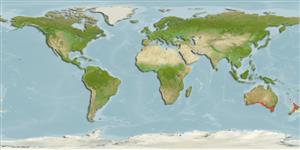分類 / Names
俗名 | 同種異名 | Catalog of Fishes(屬, 種) | ITIS | CoL | WoRMS | Cloffa
Elasmobranchii
板鰓亞綱 (鯊魚與魟魚) (sharks and rays) >
Carcharhiniformes (Ground sharks)
真鯊目 (Ground sharks) >
Triakidae (Houndsharks)
平滑鮫 (Houndsharks) > Triakinae
Etymology: Mustelus: Latin for weasel, an ancient name for sharks, possibly referring to the pointed snouts, swift movements and/or rapacious feeding behavior of smaller predatory sharks [strictly not tautonymous with Squalus mustelus Linnaeus 1758 since type was designated by the ICZN]. (See ETYFish); antarcticus: Latin for southern, referring to its distribution in the southern Pacific around Australia. (See ETYFish).
More on author: Günther.
Environment: milieu / climate zone / depth range / distribution range
生態學
海洋 居於水底的; 海洋洄游的 (Ref. 51243); 深度上下限 0 - 403 m (Ref. 76951), usually ? - 80 m (Ref. 6871). 亞熱帶的; 28°S - 44°S
Eastern Indian Ocean: endemic to southern Australia, from Western Australia through Bass Strait to Tasmania and northern New South Wales. Possibly extends northward to southern Queensland and Shark Bay in Western Australia. Confused with another undescribed species whose southern distribution extends to Dampier (20°40'S) (possibly Shark Bay) in the west and Bowen (20°S) (possibly Coffs Harbor) in the east. There is a single stock of gummy sharks in the area, however, regional stock differences might still exist.
東印度洋: 澳洲南部的特有種, 從經過 bass 海峽的西澳大利亞到塔斯梅尼亞與新南威爾斯的北方。 可能地延伸在西澳大利亞向北至昆士蘭南部與鯊魚灣。 與在西部中延伸到丹皮爾 (20 ° 40'S)(可能地鯊魚灣) 而且在東部中延伸到 Bowen(20個 °S)(可能地 Coffs 港灣) 的另一個未描述的種互相混淆了。 有在區域中的黏性鯊魚的分枝, 然而,區域系群不同可能仍然存在。
Length at first maturity / 大小 / 重量 / 年齡
Maturity: Lm 119.5, range 85 - 130 cm
Max length : 157 cm TL 雄魚/尚未辨別雌雄; (Ref. 244); 175.0 cm TL (female); 最大體重: 30.8 kg (Ref. 40637); 最大年齡: 16 年 (Ref. 6390)
An inshore and offshore shark found from intertidal waters (Ref. 13563) to a depth of 350 m. Feeds on crustaceans, marine worms and small fishes (Ref. 13563), also cephalopods. Forms schools by sex and size . Ovoviviparous (Ref. 50449). Newborn and juvenile gummy sharks are found in many areas across southern Australia, but no well-defined nursery areas have been identified. These sharks are capable of long migrations, females traveling longer distances than males (Ref. 6390). Utilized fresh for human consumption (Ref. 6871). Maximum length data for female species is taken from Ref. 6390.
一種近岸的與外海鯊魚從潮間帶的水域 (參考文獻 13563) 到深度 350 公尺發現。 吃甲殼動物,海洋的蠕蟲與小魚 (參考文獻 13563) ,也捕食頭足類。 藉著性別與大小形成魚群。 卵胎生的.(參考文獻 50449) 幼生與幼年的黏性鯊魚被發現於橫過澳洲南部的許多區域, 但是沒有很清晰繁殖場曾經鑑定。 這些鯊魚能夠長距離的迴游, 雌性被超過雄性移動更長的距離。 (參考文獻 6390) 生鮮使用供人類消費.(參考文獻 6871) 最大的長度資料母魚的種被取自參考文獻 6390.
Life cycle and mating behavior
成熟度 | 繁殖 | 產卵場 | 卵 | 孕卵數 | 仔魚
Ovoviviparous but aplacental, with 1 to 38 pups. Embryos feed solely on yolk (Ref. 50449). Gestation period ranges from 11-12 months. Newborn and juvenile gummy sharks aggregate in many areas across southern Australia but it is not known whether they inhabit defined shallow-water nursery areas. Ovulation takes place in Oct.-Dec. or Nov.- Feb. (WA). Parturition is complete by the following Dec. (Ref. 6390). The sharks are born at 30-35 cm (Ref. 6871).東印度洋: 澳洲南部的特有種, 從經過 bass 海峽的西澳大利亞到塔斯梅尼亞與新南威爾斯的北方。 可能地延伸在西澳大利亞向北至昆士蘭南部與鯊魚灣。 與在西部中延伸到丹皮爾 (20 ° 40'S)(可能地鯊魚灣) 而且在東部中延伸到 Bowen(20個 °S)(可能地 Coffs 港灣) 的另一個未描述的種互相混淆了。 有在區域中的黏性鯊魚的分枝, 然而,區域系群不同可能仍然存在。
Compagno, L.J.V., 1984. FAO Species Catalogue. Vol. 4. Sharks of the world. An annotated and illustrated catalogue of shark species known to date. Part 2 - Carcharhiniformes. FAO Fish. Synop. 125(4/2):251-655. Rome: FAO. (Ref. 244)
人類使用
漁業: 商業性; 游釣魚種: 是的
更多資訊
合作者照片Stamps, Coins Misc.聲音神經毒速度泳型鰓區Otoliths腦重體重比眼睛色素
工具
特別的報告
下載 XML
網路資源
Estimates based on models
Preferred temperature (Ref.
123201): 14.1 - 19.8, mean 16 °C (based on 126 cells).
Phylogenetic diversity index (Ref.
82804): PD
50 = 0.5000 [Uniqueness, from 0.5 = low to 2.0 = high].
Bayesian length-weight: a=0.00224 (0.00105 - 0.00478), b=3.14 (2.97 - 3.31), in cm total length, based on LWR estimates for this Genus-body shape (Ref.
93245).
營養階層 (Ref.
69278): 4.5 ±0.59 se; based on food items.
Generation time: 8.9 ( na - na) years. Estimated as median ln(3)/K based on 2
growth studies.
回復力 (Ref.
120179): 低的, 最小族群倍增時間4.5 - 14 年 (K=0.04-0.30; tm=4-6.9; tmax=16; Fec=1-38).
Fishing Vulnerability (Ref.
59153): High to very high vulnerability (74 of 100).
Nutrients (Ref.
124155): Calcium = 7.05 [2.38, 34.51] mg/100g; Iron = 0.171 [0.058, 0.673] mg/100g; Protein = 21.5 [19.0, 23.8] %; Omega3 = 0.252 [0.110, 0.600] g/100g; Selenium = 21.8 [6.6, 69.4] μg/100g; VitaminA = 10.7 [3.5, 34.3] μg/100g; Zinc = 0.316 [0.145, 0.644] mg/100g (wet weight); based on
nutrient studies.
